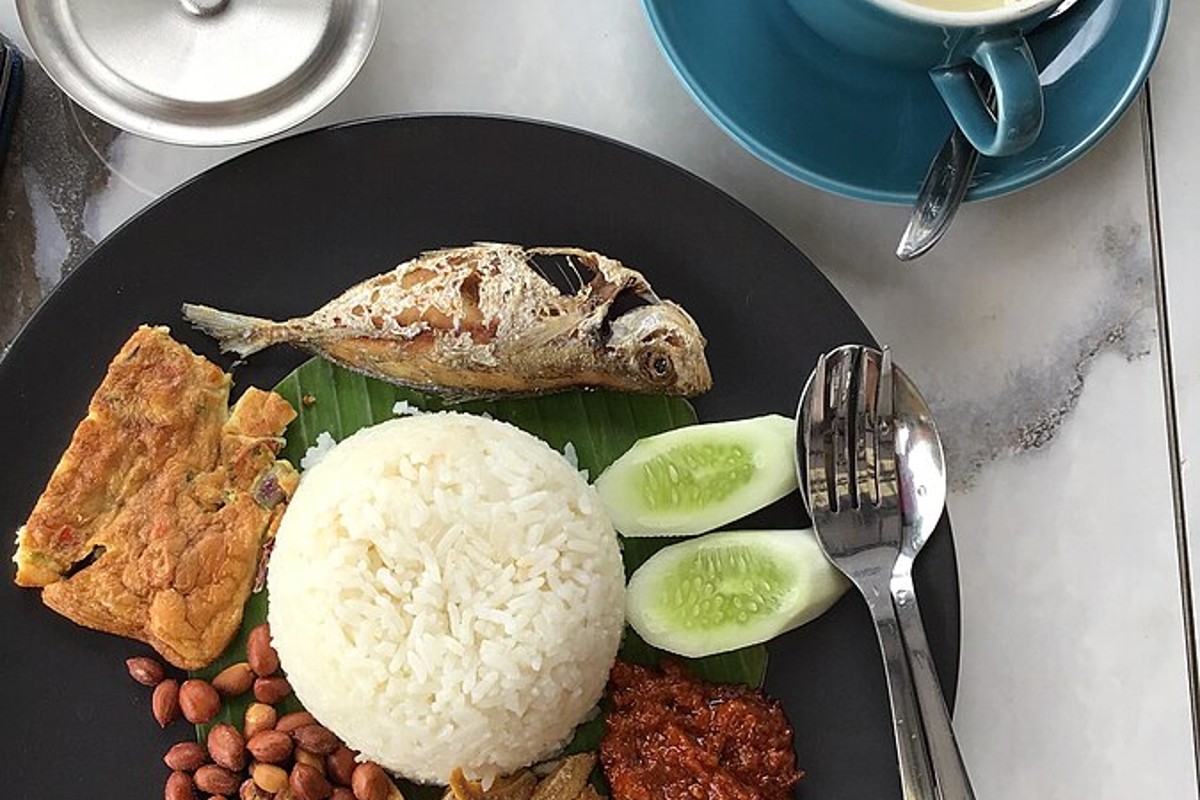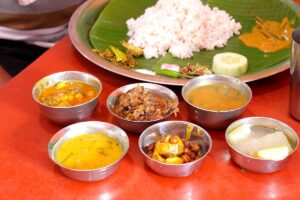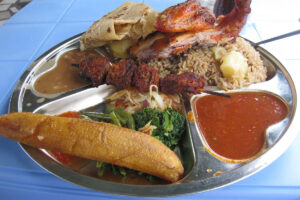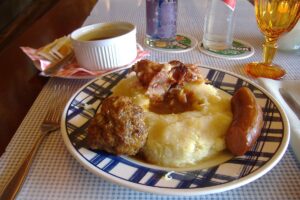Malaysia’s culinary scene is a vibrant fusion of Malay, Chinese, Indian, and indigenous influences. From bustling hawker centers to upscale restaurants, every corner of this diverse country offers a unique gastronomic experience. Prepare to be captivated by fragrant spices, vibrant curries, succulent satay, and a whole lot more. Join me as we delve into the world of Malaysia’s most popular traditional dishes, each with its own rich history and distinct flavors.
1. Nasi Lemak: Malaysia’s National Dish
Description:
Nasi Lemak is a fragrant rice dish cooked in coconut milk and pandan leaf. It’s served with a fiery sambal, crunchy fried anchovies (ikan bilis), roasted peanuts, cucumber slices, and often a protein like fried chicken (ayam goreng) or rendang. Nasi Lemak is a breakfast staple but can be enjoyed any time of day.
Recipe:
https://rasamalaysia.com/nasi-lemak-recipe/
Key Ingredients:
Rice, coconut milk, pandan leaf, sambal, ikan bilis, peanuts, cucumber, hard-boiled egg, protein (optional).
Popular Restaurant:
Village Park Restaurant in Kuala Lumpur is renowned for its Nasi Lemak with long lines forming before it even opens.
2. Nasi Kandar: Penang’s Culinary Gem
Description:
Nasi Kandar originated in Penang and is characterized by steamed rice served with a variety of curries and side dishes. The dish gets its name from the way it was traditionally sold: carried by vendors on a kandar pole. Expect a mix of meat and seafood curries, vegetables, and fragrant rice.
Recipe:
https://simple-spices.com/nasi-kandar/
Key Ingredients:
Rice, various curries (fish, chicken, beef, mutton, vegetables), fried chicken, hard-boiled eggs.
Popular Restaurant:
Line Clear Restaurant in Penang is a legendary Nasi Kandar establishment with a cult following.
3. Rendang: A Slow-Cooked Curry Masterpiece
Description:
Rendang is a rich and flavorful dry curry originating from Indonesia, but it’s incredibly popular in Malaysia too. Beef (or other meats) is slow-cooked in coconut milk and an aromatic blend of spices until the liquid evaporates, leaving behind tender, flavorful meat.
Recipe:
https://rasamalaysia.com/beef-rendang-recipe-rendang-daging/
Key Ingredients:
Beef (or chicken/lamb), coconut milk, spice paste (lemongrass, galangal, ginger, garlic, chilies), kerisik (toasted coconut), aromatics (turmeric leaf, kaffir lime leaf).
Popular Restaurant:
Restoran Rebung Chef Ismail in Kuala Lumpur serves a delicious Beef Rendang.
4. Asam Laksa: A Symphony of Sour and Spicy
Description:
Asam Laksa is a tangy and spicy fish-based noodle soup that’s a favorite in Penang. The broth is made with mackerel, tamarind, lemongrass, galangal, and chilies, resulting in a complex flavor profile that balances sourness, spice, and savory notes. Thick rice noodles, shredded fish, cucumber, pineapple, mint, and a dollop of spicy prawn paste complete the dish.
Recipe:
https://www.newmalaysiankitchen.com/authentic-penang-asam-laksa/
Key Ingredients:
Mackerel, tamarind, lemongrass, galangal, chilies, rice noodles, shredded fish, cucumber, pineapple, mint, prawn paste.
Popular Restaurant:
Asam Laksa is widely available in Penang, but a popular choice is the Air Itam Asam Laksa stall, known for its authentic and flavorful rendition.
5. Curry Laksa: Creamy and Coconutty
Description:
Curry Laksa is a creamy and rich noodle soup made with coconut milk, curry paste, and various spices. It often includes ingredients like chicken, tofu puffs, fish cakes, and cockles. The broth is slightly sweet and spicy, with a hint of coconut aroma.
Recipe:
https://glebekitchen.com/curry-laksa-malaysian-curry-mee/
Key Ingredients:
Coconut milk, curry paste, noodles (yellow mee or rice vermicelli), chicken, tofu puffs, fish cakes, cockles, bean sprouts, mint leaves.
Popular Restaurant:
Madras Lane Curry Laksa in Kuala Lumpur is a popular spot for its flavorful Curry Laksa.
6. Mee Goreng Mamak: Stir-fried Noodles with a Kick
Description:
Mee Goreng Mamak is a popular Indian-Muslim dish in Malaysia. Yellow egg noodles are stir-fried with tofu, potatoes, bean sprouts, chili paste, and a mix of sauces. It’s a savory and slightly spicy dish with a hint of sweetness, often garnished with a fried egg and a squeeze of lime.
Recipe:
https://www.joyousapron.com/mee-goreng-mamak/
Key Ingredients:
Yellow egg noodles, tofu, potatoes, bean sprouts, chili paste, soy sauce, tomato sauce, onion, garlic, lime.
Popular Restaurant:
Mee Goreng Mamak is a common street food dish found in most Mamak stalls throughout Malaysia.
7. Nasi Dagang: A Delicacy from the East Coast
Description:
Nasi Dagang is a fragrant rice dish popular in the states of Terengganu and Kelantan. The rice is cooked in coconut milk with fenugreek and lemongrass, then served with a rich fish curry (usually tuna) and a variety of side dishes like pickled vegetables and hard-boiled eggs.
Recipe:
https://www.mykeuken.com/2014/09/nasi-dagang.html
Key Ingredients:
Rice, coconut milk, fenugreek, lemongrass, tuna (or other fish), curry spices, vegetables, hard-boiled eggs.
Popular Restaurant:
Nasi Dagang can be found in restaurants specializing in East Coast Malaysian cuisine.
8. Satay: Skewered and Sizzling
Description:
Satay is a beloved Malaysian street food consisting of marinated meat skewers grilled over charcoal. The most common meats are chicken and beef, but you can also find variations like mutton, fish, or even tofu. Satay is served with a peanut sauce, cucumber and onion relish, and ketupat (rice cakes) for a complete and satisfying meal.
Recipe:
https://rasamalaysia.com/recipe-chicken-satay/
Key Ingredients:
Chicken, beef, or other meats, turmeric, lemongrass, galangal, garlic, shallots, peanut sauce, cucumber, onion, ketupat (rice cakes).
Popular Restaurant:
Satay Kajang Hj Samuri (multiple locations) – a popular chain specializing in satay with various meat options and flavorful peanut sauce.
9. Ikan Bakar: Grilled Fish with a Smokey Aroma
Description:
Ikan Bakar, or grilled fish, is a simple yet incredibly flavorful dish. Fish (usually stingray, snapper, or mackerel) is marinated in a blend of spices, including chili, turmeric, and lemongrass, then grilled over charcoal until smoky and perfectly cooked. It’s often served with a side of rice, sambal, and fresh vegetables.
Recipe:
https://greatcurryrecipes.net/2022/09/12/ikan-bakar-malaysian-fried-fish/
Key Ingredients:
Fish (stingray, snapper, mackerel), spices (chili, turmeric, lemongrass, ginger, garlic), lime juice, sambal, rice, vegetables.
Popular Restaurant:
Ikan Bakar restaurants are ubiquitous in Malaysia, particularly in coastal areas. You can find them at hawker centers and seafood restaurants.
10. Ayam Percik: A Flavorful Roasted Chicken
Description:
Ayam Percik hails from the state of Kelantan and is a succulent roasted chicken dish. The chicken is marinated in a spiced coconut milk mixture before being grilled or roasted to perfection. The marinade often includes lemongrass, ginger, garlic, and a blend of spices like turmeric and chili powder.
Recipe:
https://whattocooktoday.com/ayam-percik.html
Key Ingredients:
Chicken, coconut milk, lemongrass, ginger, garlic, turmeric, chili powder, shallots, lime juice.
Popular Restaurant:
Ayam Percik is commonly found at restaurants specializing in Kelantanese cuisine.
Conclusion
This culinary adventure through Malaysia has showcased just a fraction of the country’s diverse and vibrant food scene. From aromatic rice dishes and fiery curries to flaky breads and savory noodle soups, Malaysia has something to tantalize every taste bud. Whether you’re exploring bustling cities or quaint villages, don’t miss the opportunity to savor the authentic flavors of Malaysia.
I hope you’ve enjoyed this guide to traditional Malaysian cuisine. Feel free to ask if you have any other questions!




